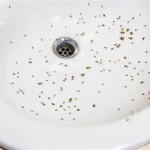Repairing a Hole in a Bathroom Sink: A Comprehensive Guide
A hole in a bathroom sink, whether small or large, is more than an aesthetic issue; it can lead to significant problems such as leaks, water damage to surrounding cabinetry, and the potential for mold growth. Addressing the issue promptly and effectively is crucial to preventing further complications and maintaining the integrity of the bathroom. This article provides a detailed guide to repairing a hole in a bathroom sink, covering various methods and materials suitable for different types of sink materials and damage severity.
Before proceeding with any repair, it is essential to identify the type of material the sink is made of. Common bathroom sink materials include porcelain, ceramic, acrylic, cast iron, and stainless steel. The material dictates the appropriate repair methods and materials. Porcelain and ceramic sinks are prone to chipping and cracking, while acrylic sinks are susceptible to scratches and impact damage. Cast iron sinks are durable but can experience rusting if the protective enamel coating is compromised. Stainless steel sinks, though generally resistant to damage, can be dented or punctured.
Safety is paramount when undertaking any repair project. It is recommended to wear eye protection and gloves to prevent injury from debris or chemicals. Ensure the work area is well-ventilated, especially when using adhesives or solvents. Always turn off the water supply to the sink before commencing any repairs to prevent flooding.
Assessing the Damage and Selecting the Appropriate Repair Method
The first step in repairing a hole in a bathroom sink is to thoroughly assess the extent of the damage. Consider the size and location of the hole, as well as the overall condition of the sink. Small chips and cracks can often be repaired with epoxy or patching compounds, while larger holes may necessitate more extensive repairs, such as using a fiberglass repair kit or even replacing the entire sink. The choice of repair method depends on the material of the sink and the severity of the damage.
For minor chips and cracks in porcelain or ceramic sinks, a porcelain repair kit is often the most suitable option. These kits typically include a two-part epoxy filler and a color-matching glaze. The filler is used to fill the chip or crack, and the glaze is applied to conceal the repair and restore the sink's original appearance. It is crucial to carefully follow the manufacturer's instructions to ensure a successful repair.
Larger holes in porcelain or ceramic sinks may require a more substantial repair. In such cases, a two-part epoxy putty can be used to fill the hole. The putty is mixed according to the manufacturer's instructions and then applied to the damaged area. Once the putty has hardened, it can be sanded smooth and painted to match the color of the sink. This method is particularly effective for repairing cracks and chips that extend through the entire thickness of the sink.
Acrylic sinks can be repaired using a specialized acrylic repair kit. These kits typically include an acrylic filler, a hardener, and a polishing compound. The filler is mixed with the hardener and then applied to the damaged area. Once the filler has cured, it can be sanded smooth and polished to restore the sink's original shine. Acrylic repair kits are designed to bond securely to acrylic surfaces and provide a durable, long-lasting repair.
For cast iron sinks with enamel damage, a rust converter can be applied to prevent further corrosion. The rust converter transforms the rust into a stable compound that can be painted over. After applying the rust converter, an enamel repair kit can be used to fill the damaged area and restore the sink's original finish. Enamel repair kits typically include an epoxy filler and a color-matching enamel paint.
Step-by-Step Repair Process
Regardless of the chosen repair method, proper preparation is essential for a successful outcome. Clean the area around the hole thoroughly with a mild detergent and water. Remove any loose debris or flaking paint. If the area is greasy or oily, degrease it with a solvent such as isopropyl alcohol. Allow the area to dry completely before proceeding.
Next, sand the area around the hole with fine-grit sandpaper to create a slightly roughened surface. This will help the repair material adhere more effectively. Wipe away any sanding dust with a clean, damp cloth. Protect the surrounding area with masking tape to prevent accidental damage from the repair material.
If using a two-part epoxy filler, mix the epoxy components according to the manufacturer's instructions. Most epoxies require a specific mixing ratio to ensure proper curing. Use a clean mixing container and a stirring stick to thoroughly combine the components. Apply the epoxy to the hole, filling it completely and slightly overfilling it to allow for sanding. Use a putty knife or similar tool to smooth the epoxy and remove any excess material.
Allow the epoxy to cure completely according to the manufacturer's instructions. Curing times can vary depending on the type of epoxy and the ambient temperature. Avoid disturbing the repair during the curing process to ensure a strong, durable bond.
Once the epoxy has cured, sand the repaired area smooth with progressively finer grits of sandpaper. Start with a medium-grit sandpaper to remove any high spots or imperfections. Then, switch to a fine-grit sandpaper to create a smooth, seamless surface. Be careful not to sand too aggressively, as this could damage the surrounding surface.
If necessary, apply a color-matching paint or glaze to conceal the repair. Choose a paint or glaze that is specifically designed for use on bathroom sinks. Apply the paint or glaze in thin, even coats, allowing each coat to dry completely before applying the next. Use a fine-tipped brush to apply the paint or glaze to small areas, and a foam roller to apply it to larger areas.
Finally, remove the masking tape and clean the repaired area with a mild detergent and water. Polish the area with a soft cloth to restore its shine. Inspect the repair carefully to ensure that it is smooth, seamless, and watertight.
Materials and Tools Required
The specific materials and tools required for repairing a hole in a bathroom sink will vary depending on the chosen repair method. However, some common materials and tools include:
- Porcelain repair kit, acrylic repair kit, or enamel repair kit (depending on the sink material)
- Two-part epoxy putty
- Rust converter (for cast iron sinks)
- Sandpaper (various grits)
- Masking tape
- Putty knife or similar tool
- Mixing container and stirring stick
- Color-matching paint or glaze
- Fine-tipped brush or foam roller
- Mild detergent and water
- Soft cloth
- Isopropyl alcohol (for degreasing)
- Eye protection and gloves
Purchasing a comprehensive repair kit is often the most convenient way to acquire all the necessary materials. These kits typically include all the required components and detailed instructions.
Preventative Measures and Long-Term Maintenance
While repairing a hole in a bathroom sink can restore its functionality and appearance, taking preventative measures to avoid future damage is crucial. Avoid dropping heavy objects into the sink, as this can cause chips and cracks. Use sink mats or protective liners to prevent scratches and stains. Clean the sink regularly with a mild detergent and water to remove soap scum and mineral deposits. Avoid using abrasive cleaners, as these can damage the surface of the sink.
For cast iron sinks, regularly inspect the enamel coating for any signs of damage. Repair any chips or cracks promptly to prevent rusting. Apply a protective wax coating to the enamel to help prevent staining and corrosion. Avoid using harsh chemicals or abrasive cleaners on cast iron sinks, as these can damage the enamel coating.
In the event of a clog, avoid using harsh drain cleaners, as these can damage the sink and plumbing. Instead, try using a plunger or a drain snake to clear the clog. If the clog persists, consult a professional plumber.
By following these preventative measures and performing regular maintenance, it is possible to prolong the lifespan of a bathroom sink and avoid the need for costly repairs.

How To Fix A Chipped Porcelain Sink

How To Fix A Chipped Sink

How Can I Repair A Hole In Vanity Sink Hometalk

How To Replace A Bathroom Sink Drain

Bathroom Sink Drain Stopper Not Working

How To Repair Hole In Ceramic Sink Bunnings Work Community

How To Fix Bathroom Sink Drain Leaks Underneath Gasket Threads Solved

Magic 0 17 Oz Porcelain Chip Fix Repair For Tubs And Sinks 3007a The Home Depot

How To Fix Bathroom Sink Drain Leaks Underneath Gasket Threads Solved

How To Fix A Chipped Sink Diy Family Handyman
Related Posts







